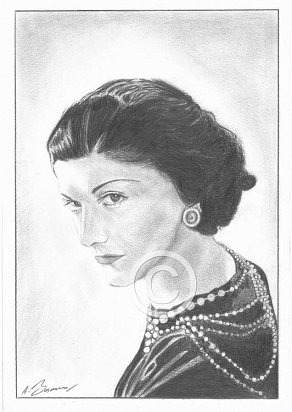Gabrielle Chanel
Pencil Portrait by Antonio Bosano.

Shopping Basket
The quality of the prints are at a much higher level compared to the image shown on the left.
Order
A3 Pencil Print-Price £45.00-Purchase
A4 Pencil Print-Price £30.00-Purchase
*Limited edition run of 250 prints only*
All Pencil Prints are printed on the finest Bockingford Somerset Velvet 255 gsm paper.
P&P is not included in the above prices.



Comments
Hal Vaughn is an American author based in Paris, France. He has held several posts as a US Foreign Service officer before becoming a journalist on assignments in Europe, the Middle East, and Southeast Asia. He has also served in the United States Military in both World War II and Korea, and was involved in a number of covert intelligence activities as a U.S. Foreign Service Officer at Karachi and Geneva during the Cold War. His French-born wife, now deceased, worked with the U.S. intelligence community in Geneva, whilst the man himself, undoubtedly has intimate knowledge of clandestine, international operations.
In 2011, Vaughn published his biography of Gabrielle Coco Chanel, prompting CHANEL® to dismiss the work as pure fiction. Defending the reputation of its founder with a terse public statement, the high fashion house that specializes in haute couture and ready-to-wear clothes, luxury goods and fashion accessories, was moved to comment:
‘More than 57 books have been written about Gabrielle [Coco] Chanel. To decide for yourself, we would encourage you to consult some of the more serious ones’.
Personally, I’m unconvinced Vaughn is little more than a ‘trash novelist’, but I accept that he will be reviled in certain quarters – after all, his biography asserts that today’s most coveted handbags, perfumes and tweed jackets are the creations of a confirmed Nazi spy, who cavorted with SS officers at the Hotel Ritz throughout the war, and became the richest woman in the world thanks to the Nazi seizure of all Jewish-owned property and business enterprises.
If we can divorce ourselves from blind patriotism, then we can also accept that it must be extraordinarly difficult to resist a ruthlessly enforced tyranny like Naziism, especially in a densely populated country with little wilderness. Money remains an essential commodity in order to eat and provide for one’s family. All commerce and industry must be conducted according to the will of the occupiers, and any entrepreneur refusing dictation will lose his business. Members of a family that own a house are liable to find it burnt about their ears if they commit, or are even deemed to have acquiesced in, acts of resistance. Some people may feel brave enough to accept such consequences for themselves, but would they inflict them on their children?
Unlike communist revolutionaries, the Nazis did not threaten Aristocratic material interests and this, to some degree, calmed the very real morbid terror of the extreme left. It is little surprising therefore, that the French aristocracy collaborated almost wholesale with their German rulers throughout the period 1940-44 – with so much at stake, both materially and socially – only the few would side with the resistance. Overcoming nationalistic tendencies rather more easily than many of my contemporaries – if only because of my mixed parentage – I think it fair to say that, had operation Sea Lion succeeded, then many British grandees who had fought bravely in the Second World War would, have bowed to the Germans under occupation rather than forfeit the likes of Chatsworth or Blenheim. Witnessing the V1 and V2 bombs falling every night on London, my teenage father’s all pervading thought was nothing if not consistent : ‘Why don’t we surrender?’ he would repeatedly mutter under his breath. The British aristocracy would have been similarly pragmatic and acquiescent. ‘Yes, we hate the Germans but we must face the fact that they are the masters now’. With Edward VIII restored to the throne and a puppet Government in place, life in Britain would have been one of daily collaboration with ‘the enemy’. In reviewing the life of Coco Chanel, let us therefore not rush to judgement.
Under construction
In 1921, while working on the creation of a perfume for Coco Chanel, Ernest Beaux further refined Armingeat’s work on the first aldehydic based fragrance Rêve D\‘Or (Golden Dream).
http://en.wikipedia.org/wiki/Ernest_Beaux
Aldehydes are organic compounds present in many natural materials, including roses, natural citrus essences such as orange rind, rose oil, pine essence, citronella, cinnamon bark and bovine heart muscle. Chanel No. 5 (and later the No. 22) used a bouquet of aliphatic or “fatty” aldehydes (C10, C11, and C12) that together combined to produce a crisp citrus-and-floral scent, with a pronounced soapy tone. Fatty aldehydes contain long chains of carbon atoms (8-13) connected to an aldehyde group.
Beaux originally made up 10 individually numbered versions of the scent, with Coco choosing the one most heavily reliant on Jasmine Oil. At the time, it was one of the most costly ingredients to extract, thus ensuring the No. 5’s pole position as the most expensive perfume in the world. Whilst impossible to prove, a bottle of Chanel No 5 is reputedly sold somewhere in the world, every minute of every day.